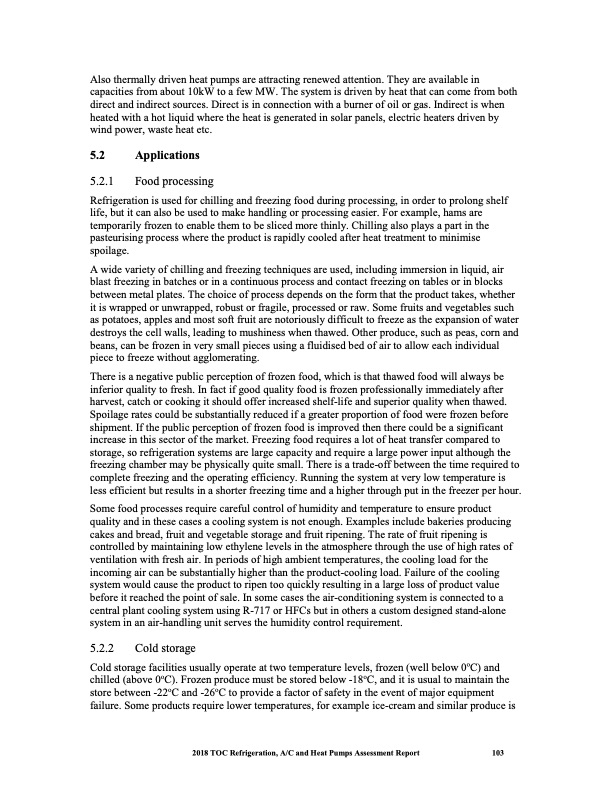
PDF Publication Title:
Text from PDF Page: 116
Also thermally driven heat pumps are attracting renewed attention. They are available in capacities from about 10kW to a few MW. The system is driven by heat that can come from both direct and indirect sources. Direct is in connection with a burner of oil or gas. Indirect is when heated with a hot liquid where the heat is generated in solar panels, electric heaters driven by wind power, waste heat etc. 5.2 Applications 5.2.1 Food processing Refrigeration is used for chilling and freezing food during processing, in order to prolong shelf life, but it can also be used to make handling or processing easier. For example, hams are temporarily frozen to enable them to be sliced more thinly. Chilling also plays a part in the pasteurising process where the product is rapidly cooled after heat treatment to minimise spoilage. A wide variety of chilling and freezing techniques are used, including immersion in liquid, air blast freezing in batches or in a continuous process and contact freezing on tables or in blocks between metal plates. The choice of process depends on the form that the product takes, whether it is wrapped or unwrapped, robust or fragile, processed or raw. Some fruits and vegetables such as potatoes, apples and most soft fruit are notoriously difficult to freeze as the expansion of water destroys the cell walls, leading to mushiness when thawed. Other produce, such as peas, corn and beans, can be frozen in very small pieces using a fluidised bed of air to allow each individual piece to freeze without agglomerating. There is a negative public perception of frozen food, which is that thawed food will always be inferior quality to fresh. In fact if good quality food is frozen professionally immediately after harvest, catch or cooking it should offer increased shelf-life and superior quality when thawed. Spoilage rates could be substantially reduced if a greater proportion of food were frozen before shipment. If the public perception of frozen food is improved then there could be a significant increase in this sector of the market. Freezing food requires a lot of heat transfer compared to storage, so refrigeration systems are large capacity and require a large power input although the freezing chamber may be physically quite small. There is a trade-off between the time required to complete freezing and the operating efficiency. Running the system at very low temperature is less efficient but results in a shorter freezing time and a higher through put in the freezer per hour. Some food processes require careful control of humidity and temperature to ensure product quality and in these cases a cooling system is not enough. Examples include bakeries producing cakes and bread, fruit and vegetable storage and fruit ripening. The rate of fruit ripening is controlled by maintaining low ethylene levels in the atmosphere through the use of high rates of ventilation with fresh air. In periods of high ambient temperatures, the cooling load for the incoming air can be substantially higher than the product-cooling load. Failure of the cooling system would cause the product to ripen too quickly resulting in a large loss of product value before it reached the point of sale. In some cases the air-conditioning system is connected to a central plant cooling system using R-717 or HFCs but in others a custom designed stand-alone system in an air-handling unit serves the humidity control requirement. 5.2.2 Cold storage Cold storage facilities usually operate at two temperature levels, frozen (well below 0oC) and chilled (above 0oC). Frozen produce must be stored below -18oC, and it is usual to maintain the store between -22oC and -26oC to provide a factor of safety in the event of major equipment failure. Some products require lower temperatures, for example ice-cream and similar produce is 2018 TOC Refrigeration, A/C and Heat Pumps Assessment Report 103PDF Image | Heat Pumps Technical Options

PDF Search Title:
Heat Pumps Technical OptionsOriginal File Name Searched:
RTOC-assessment-report-2018_0.pdfDIY PDF Search: Google It | Yahoo | Bing
CO2 Organic Rankine Cycle Experimenter Platform The supercritical CO2 phase change system is both a heat pump and organic rankine cycle which can be used for those purposes and as a supercritical extractor for advanced subcritical and supercritical extraction technology. Uses include producing nanoparticles, precious metal CO2 extraction, lithium battery recycling, and other applications... More Info
Heat Pumps CO2 ORC Heat Pump System Platform More Info
| CONTACT TEL: 608-238-6001 Email: greg@infinityturbine.com | RSS | AMP |